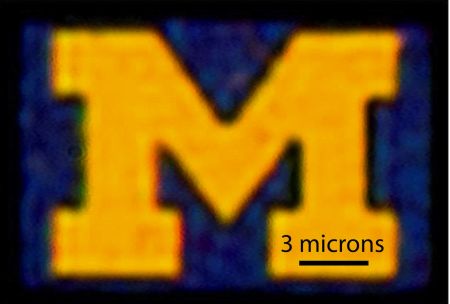Browsing This
Better Than Retina: The Next Big Display Technology
>

An optical microscopy picture of the 12-by-9-micron University of Michigan trademark constructed with this brand-new tone filter process. Credit: Jay Guo>View all
Apple claims which the iPhone 4 “retina display” has pixels so small a tellurian eye can’t distinguish a single from the alternative. Researchers during a University of Michigan contend they can kick that pixel firmness by an sequence of bulk — as well as make screens which have been easier to make as well as some-more fit to irradiate too.
The technology — called plasmonic nanophotonics — works the small like the rainbow, if light were refracted by nano-thin steel grates instead of raindrops. Vary the spacing between a grates, as well as white light appears in dissimilar colors. Instead of the mixed layers of potion, metal polarizers, and filter sheets in the conventional LCD, a polarizer is the tone filter. The total color component of the shade is the three-layer all-metal dielectric stack.
The appetite assets have been potentially tremendous. According to Michigan engineering professor expert Jay Guo, only about 5 percent of a backlight in an LCD screen actually reaches the eyes. This equates to you could use a technology in visual chip-to-chip communications, or even fiberoptics without a essential element. It could also be used to have high-efficiency, high-resolution projectors, or stretchable color screens.
And yes — it does concede for a production of intensely tiny color pixels, reduction than 10 microns. That U of M trademark in a first image on top of? It’s about 12 x 9 microns, or 1/6 the width of the tellurian hair.
University of Michigan around R&D Magazine. Images pleasantness of a University of Michigan as well as Apple.




